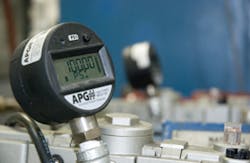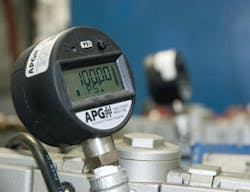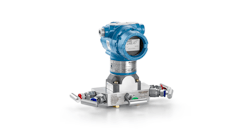5 Tips to Increase the Longevity of a Pressure Sensor
So, in the spirit of avoiding pressure sensor replacement as long as possible, here are five tips and tricks that will increase the longevity of pressure sensors in most application environments.
1. Select an effective pressure range
A pressure-sensing element is a moving part, which means it can be over-worked, strained, and broken if it is continuously used at or beyond the maximum capacity of the sensor. This may seem counter-intuitive—the inclination may be to think that if the application pressure is a steady 100 PSI, then a 100 PSI sensor would be the best choice. However, this is not ideal.
Instead, think of a pressure-sensing element as an elastic band. If it is stretched and held at the maximum length, it would soon degrade and eventually break. Pressure sensors work on the same principle, but instead of elastic rubber, there is a thin diaphragm made usually of metal.
2. Protect the sensor diaphragm before, during, and after installation
The pressure sensors diaphragm is designed to be sensitive to pressure forces; this does not mean that it can withstand other types of force applied to it. In fact, it is just the opposite. The diaphragm is the most fragile part of the pressure sensor and requires special consideration when it is handled.
Anything that happens to the sensor diaphragm that affects how it moves will change how the sensor performs. For example, sharp impacts can cause a dent in the diaphragm, which will damage the accuracy of the sensor. If the diaphragm is not physically damaged, it can still cause the sensor output to begin drifting.
3. Manage the application environment
Temperature: Most data sheets offer compensated, operational, and storage thermal ranges. While they are all important to the life and performance of your pressure transducer, the one to be most concerned with is the operational temperature range. The best approach is to ensure a sensor meets all the expected thermal requirements of the application. This avoids a potentially troublesome work-around.
Chemical Compatibility: The media and external environment must also be compatible with your sensor, just as temperature must. The surface that the media touches is called the wetted surface, and is more important because an incompatibility here will cause sensor failure much faster. However, for the sensor to last, it must be constructed of material that is unaffected by any chemicals and corrosive gasses in or around the application area.
Moisture: If the sensor is in an outdoor, humid, or otherwise wet environment, the sensor case should have an IP or NEMA rating appropriate for the environment. If it does not, then install it in an enclosure that does have such a rating.
4. Wiring
There are a few forms of electromagnetic interference (EMI) that can affect the life of the sensor. EMI will do more than reduce the performance of sensors in the short term; it can degrade or destroy them permanently. When wiring the sensor, make sure it is wired and grounded correctly per the manufacturer’s instructions.
5. Recalibrations
Manufacturers, as previously mentioned, go to great lengths to neutralize the drift by artificial or accelerated aging to a level of drifting that will be acceptable to the user. These effects in the field will only be seen over time, if ever.
After an extended period, it is possible for the sensor to drift outside the acceptable performance range. The user can typically fix this with a zero balance or an offset adjustment made to the sensor. Therefore, a sensor with an adjustment feature can extend longevity. Take advantage of these adjustments before disposing of the pressure transducer, or send it back for recalibration.
RELATED: "15 Tips to Improve Pressure Sensor Performance"
Elden Tolman is a product development engineer at Automation Products Group, Inc. (APG, www.apgsensors.com). After earning a bachelor’s degree in Engineering from Utah State University, Mr. Tolman has worked at APG for nine years. Currently he manages nine product lines, with hundreds of options ranging from outputs to process connections. He actively provides technical support to a range of large end-user companies in various industries. Mr. Tolman can be reached at 435 753-7300 or [email protected].
This post is based on a more detailed feature article that will appear in the February 2013 issue of Flow Control magazine. If you are not yet a subscriber to Flow Control magazine, you can register for a free subscription here.



